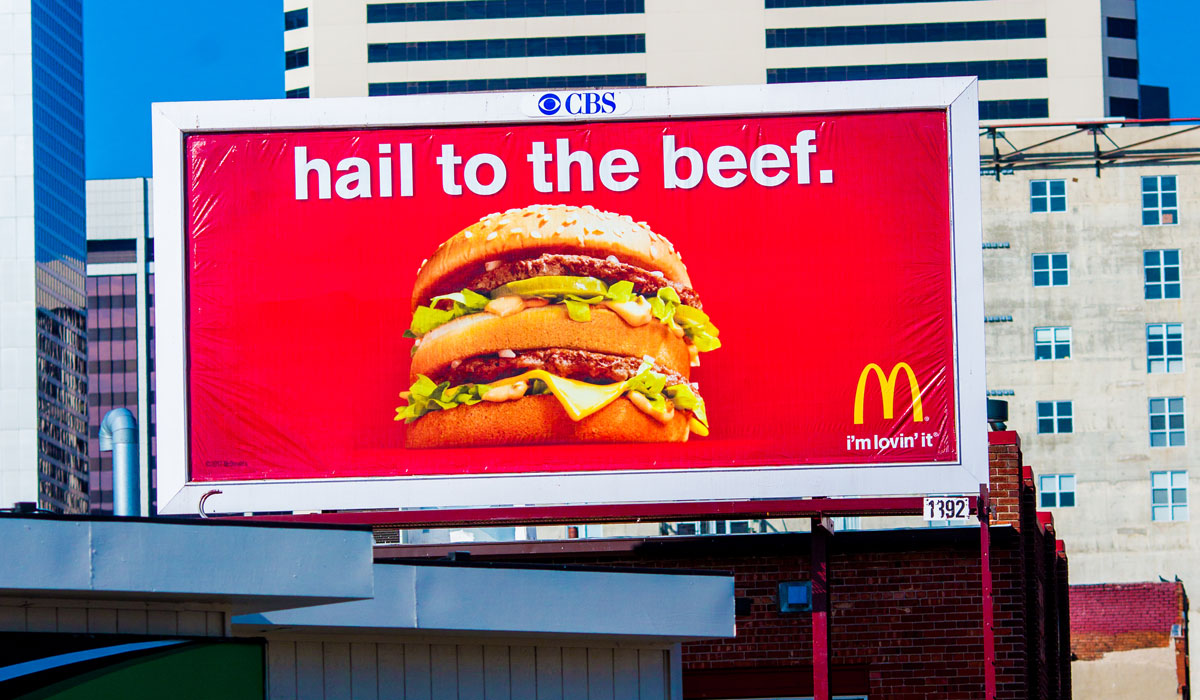For years, quick-service restaurant operators have faced a surging competitive landscape—one that includes food trucks, meal delivery services, subscription meal services and expanded dining options. Quick-serves have also been confronted with increased competition in the digital world, vying for consumer attention and engagement via apps, social media, digital advertisements and email marketing campaigns.
Now, with state and local entities lifting restrictions and people nationwide ready to break away from the year’s lockdowns, the return to restaurant dining is in full swing. Success for quick-service restaurants will hinge on how well positioned operators are to leverage the latest shifts in customer behavior to rise above the fray, engage restaurant goers, and ultimately drive consumers to their doors.
Fortunately, Out-of-Home (OOH) advertising is an effective way to stand out from mounting, noisy competition. Here’s what to know:
OOH advertising goes way beyond billboards
OOH advertising is any physical advertisement consumers encounter outside of their home. While static billboards dotting highways and digital billboards adorning downtowns are the archetype of outdoor advertising, OOH options don’t end here. Wallscapes, bus benches, transit stations and car-top ads also come into play for quick-serves.
What’s important is this: OOH can be found everywhere and it truly stands out. A recent study from Simmons shows 7 in 10 fast food consumers reported noticing an OOH ad in the last 30 days. That’s good news for restaurants as 85 percent of diners make their decisions on where to eat on the same day. Quick-service restaurants can capitalize on consumer behavior by implementing OOH ads to drive website and foot traffic to their businesses.
How Quick-Serves can leverage OOH advertising
As is true with all other advertising channels, how restaurant and quick-service marketers leverage OOH should be grounded in clear objectives. These differ from industry to industry, but for quick-service restaurants they include:
Building brand awareness: If the aim is to etch a restaurant or fast-food chain into the minds of consumers, OOH is an effective means to do so—especially now that people are rediscovering their surroundings post-COVID. This is where big brands go bold with high-dollar campaigns blanketing key markets. But even on a smaller scale, independently owned restaurants will benefit from a brand standpoint when building a name in their community, opening new locations, and promoting new offerings.
Driving foot traffic: Quick-serves can place ads in close proximity to their locations to increase foot traffic. These should be leveraged in key places like along highways and within a close radius to their locations so consumers can find them, even if off the beaten path.
Reach a niche audience: New OOH buying platforms feature advanced targeting features that enable restaurants to identify, target, reach and engage consumers with more precision than ever before. More specifically, they can reach customers in new markets, target niche customers like late-night diners or travelers, and engage consumers with targeted ads at gas station kiosks or transit-wrapped ads.
How to make the most of an OOH campaign
Deciding to test OOH is step one. The next is determining how to get the most bang for the buck and make the biggest impact. A few tried and true tactics to ensure the most effective campaign include:
Get Creative: Creative OOH ads, which are more likely to “go viral” than any other media, gives brands the opportunity to be bold. No idea is too far-fetched, just ask Chick-Fil-A (see: cows with poor grammar imploring passersby to “Eat mor chikin.”). OOH’s flexibility allows marketers to launch ads with vibrant, eye-catching graphics that can grab the attention of pedestrians and drivers, and entice them to walk through your doors.
Use Point-of-Interest Targeting & Strong Calls-to-Action: No other medium is better suited to reach potential customers at an optimal time––while they’re in close proximity to your restaurant. New OOH buying platforms feature point-of-interest targeting, which makes it easy to surface all available OOH ad units near your brick-and-mortar locations. Keep CTAs simple and direct. Be sure to include clear messaging for what consumers need to know or do, whether it’s “Turn left in one mile” or “Order online now.”
Consider the Ad Format: Large, high-impact outdoor ad units are great for driving awareness of a restaurant, new menu items, locations, or delivery services. And, while including social icons and app plugs may not be relevant to a billboard ad campaign, they are ideal for bus benches, wallscapes and transit station ads, which are able to engage people as they wait or walk by.
Drive People to Websites & Apps: Street-level ad formats with specific CTAs to visit websites and apps can encourage diners to place online orders or join loyalty clubs. With OOH campaigns, restaurants can incorporate interactive technology in their ads like QR codes, app clips, and text-to offers that drive local traffic and incentivize consumers to take action on their mobile devices. Another added plus? New OOH buying platforms are able to link OOH ad exposures to website visits, so you can measure the effectiveness of your OOH campaigns.
Make Sure to Measure What Matters: When it comes to measuring an OOH campaign, quick-serves need to look beyond vanity metrics. Modern OOH buying platforms can help measure OOH to the same degree a digital campaign is measured. Through OOH buying platforms, restaurant marketers can track and isolate the effectiveness of their OOH buys, by attributing offline or online conversations, and measuring lift in social media mentions, brand awareness, restaurant foot traffic, and more.
In the end, there is no one-size-fits-all strategy for restaurant and quick-service marketers planning, launching, and measuring an OOH campaign. Rather, there is a diverse range of formats and tools for every goal and budget to help eateries stand out from the crowd, rise above the digital clutter, and see success.
Matthew O’Connor is the CEO and co-founder of AdQuick, the first platform to allow brands, agencies and individuals to complete the entire process of planning, buying, executing and measuring out-of-home (OOH) advertising campaigns anywhere in the U.S.












